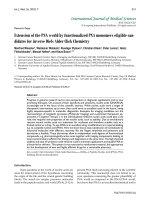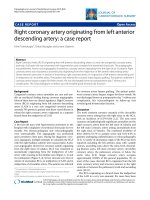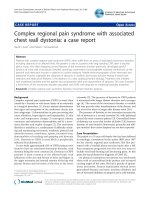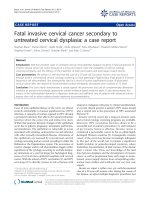Báo cáo y học: " Fibrolipoma of the lip treated by diode laser surgery: A case report" pps
Bạn đang xem bản rút gọn của tài liệu. Xem và tải ngay bản đầy đủ của tài liệu tại đây (821.02 KB, 3 trang )
BioMed Central
Page 1 of 3
(page number not for citation purposes)
Journal of Medical Case Reports
Open Access
Case report
Fibrolipoma of the lip treated by diode laser surgery: A case report
Saverio Capodiferro*
1
, Eugenio Maiorano
2
, Francesco Scarpelli
3
and
Gianfranco Favia
1
Address:
1
Department of Dentistry and Surgery, University of Bari, Piazza Giulio Cesare, 70124 Bari, Italy,
2
Department of Pathological Anatomy,
University of Bari, Bari, Italy and
3
University of Florence, Florence, Italy
Email: Saverio Capodiferro* - ; Eugenio Maiorano - ;
Francesco Scarpelli - ; Gianfranco Favia -
* Corresponding author
Abstract
Introduction: Several neoplasms of the adipose tissue can involve the soft tissues of the head and
neck region. These neoplasms are mainly treated surgically and an accurate histological examination
is mandatory for a precise diagnosis.
Case presentation: We report a case of fibrolipoma involving the lower lip of a 43-year-old man,
which was successfully treated by diode laser surgery. This approach allowed adequate resection
of the neoplasm with minimal damage to the adjacent tissues, thus reducing post-surgical scarring.
Conclusion: Diode laser surgery for the treatment of benign lesions of the oral mucosa appears
to be a convenient alternative to conventional blade surgery and has proved to be effective for the
excision of fibrolipoma of the lip. The possibility of avoiding direct suture after excision is surely
helpful when aesthetic areas, such as the lip, are surgically treated. For these reasons, and also
considering the lower histological alteration of the specimen obtained with diode laser surgery if
adequately used, the diode laser is undoubtedly a good alternative to conventional surgery.
Introduction
Although the occurrence of conventional lipoma in the
head and neck area is relatively high, fibrolipoma is quite
rare within the oral cavity, particularly in the lip. This may
result in equivocal differential diagnosis on clinical
grounds and for this reason, subsequent histological
examination is mandatory to confirm the nature of the
tumour.
Case presentation
A 43-year-old man was referred to the Department of
Dentistry and Surgery of the University of Bari for a pain-
less swelling of the buccal mucosa of the lower lip of 8
months duration. At clinical examination, the lesion
appeared soft and well separated from the surrounding
tissues and was covered by intact mucosa (Fig. 1). No den-
tal trauma was referred.
With a provisional clinical diagnosis of benign neoplasm,
the lesion was surgically excised under local anaesthesia,
using a diode laser with a 300 μm fibre and operating at
2,5 W. Direct suture of the surgical margins was unneces-
sary as no bleeding was observed during and following
the excision (Fig. 2).
The surgical specimen was fixed in 10% buffered forma-
lin, embedded in paraffin, cut and stained with haematox-
ylin-eosin. The histological preparations showed an
Published: 12 September 2008
Journal of Medical Case Reports 2008, 2:301 doi:10.1186/1752-1947-2-301
Received: 22 August 2007
Accepted: 12 September 2008
This article is available from: />© 2008 Capodiferro et al; licensee BioMed Central Ltd.
This is an Open Access article distributed under the terms of the Creative Commons Attribution License ( />),
which permits unrestricted use, distribution, and reproduction in any medium, provided the original work is properly cited.
Journal of Medical Case Reports 2008, 2:301 />Page 2 of 3
(page number not for citation purposes)
admixture of mature adipose tissue, including variably
sized typical adipocytes, embedded within dense collagen
fibres (Fig. 3), consistent with fibrolipoma. Regressive
changes of the tissues located at the surgical margins, such
as cellular hyperbasophilia, nuclear chromatin condensa-
tions or tissue coarctation were not detected.
The postoperative course was uneventful, with evident
reduction of the surgical scar after 10 days and without
signs of recurrence during a 10-month follow-up.
Discussion
Fibrolipoma is a benign tumour that rarely occurs in the
oral and maxillofacial region, and is classified as a variant
of conventional lipoma by the WHO [1]. Overall, lipomas
represent 1% to 4.4% of all benign lesions of the oral cav-
ity, and most frequently occur in the buccal mucosa, lip,
tongue, palate and floor of the mouth [2-4]. Several vari-
ants of lipoma have been described, including angiol-
ipoma, chondroid lipoma, myolipoma, spindle cell/
pleomorphic lipoma, diffuse lipomatous proliferations
(lipomatosis) and hibernoma [1], some of which show
distinctive clinico-pathological features that are usually
discernible only after histological examination. Liposar-
coma of the oral cavity is exceedingly rare [5], but this
entity cannot be distinguished from its benign counter-
part at clinical examination. Therefore, accurate histolog-
ical examination is mandatory, and the differential
diagnosis is based on the detection of a lack of lobular
architecture, areas of prominent fibrosis and, most impor-
tantly, on the presence of multivacuolated adipose cells
with indented nuclei (lipoblasts), which are typically
present in liposarcoma in variable proportions.
The treatment of fibrolipoma is exclusively surgical but, to
the best of the authors' knowledge, the use of diode laser
surgery for oral fibrolipoma has not been reported previ-
Clinical appearance of fibrolipomaFigure 1
Clinical appearance of fibrolipoma. This lesion usually
presents as an asymptomatic swelling of soft consistency,
mobile on the surrounding tissues.
Clinical appearance of the surgical scar 10 days after surgeryFigure 2
Clinical appearance of the surgical scar 10 days after
surgery. The use of a diode laser with a 300 μm fibre and
operating at 2,5 W allowed prompt recovery of the patient,
with no inaesthetic alterations of the adjacent tissues.
Histological features of fibrolipoma at high-power magnifica-tionFigure 3
Histological features of fibrolipoma at high-power
magnification. The tumour is composed of mature and uni-
vacuolated fat cells, embedded in dense collagen fibres. No
morphological or structural alterations of the tissues due to
the thermal cut of the diode laser are detectable (haematox-
ylin-eosin stain, original magnification ×20).
Publish with BioMed Central and every
scientist can read your work free of charge
"BioMed Central will be the most significant development for
disseminating the results of biomedical research in our lifetime."
Sir Paul Nurse, Cancer Research UK
Your research papers will be:
available free of charge to the entire biomedical community
peer reviewed and published immediately upon acceptance
cited in PubMed and archived on PubMed Central
yours — you keep the copyright
Submit your manuscript here:
/>BioMedcentral
Journal of Medical Case Reports 2008, 2:301 />Page 3 of 3
(page number not for citation purposes)
ously. In comparison with conventional blade surgery,
laser excision seems more convenient in view of several
intra-operative advantages (such as the lack of bleeding,
no requirement for suture) and postoperative advantages
(for example, faster scar healing, no inaesthetic sequelae).
Furthermore, regressive tissue changes due to the thermal
cut of the diode laser are usually negligible, as noted in the
current study, thus allowing adequate histological exami-
nation and correct diagnosis.
Conclusion
Diode laser surgery for the treatment of benign lesions of
the oral mucosa appears to be a convenient alternative to
conventional blade surgery and has proved to be effective
for the excision of fibrolipoma of the lip. In our patient,
this surgical procedure allowed conservative treatment of
the tumour, with no intra-operative haemorrhage, mini-
mal tissue scarring, prompt recovery of the patient and
without damage to the histological features of the lesion
that might impair the correct diagnosis.
Competing interests
The authors declare that they have no competing interests.
Consent
Written informed consent was obtained from the patient
for publication of this case report and any accompanying
images. A copy of the written consent is available for
review by the Editor-in-Chief of this journal.
Authors' contributions
SC, FS and GF carried out the surgical procedure with the
diode laser while EM performed the histological examina-
tion. SF prepared the first draft of the manuscript while GF
and EM undertook manuscript revision and editing. All
authors read and approved the final manuscript.
Acknowledgements
The authors wish to thank KaVo for technical support and for supplying the
GENTLEray 980 diode laser used for the surgical procedures.
References
1. Fletcher CDM, Unni KK, Mertens F: Adipocytic tumors. In Pathol-
ogy and Genetics: Tumours of Soft Tissue and Bone. World Health Organ-
ization Classification of Tumours Lyon, France: IARC Press; 2002:9-46.
2. Fregnani ER, Pires FR, Falzoni R, Lopes MA, Vargas PA: Lipomas of
the oral cavity: clinical findings, histological classification and
proliferative activity of 46 cases. Int J Oral Maxillofac Surg 2003,
32:49-53.
3. Lombardi T, Odell EW: Spindle cell lipoma of the oral cavity:
report of a case. J Oral Pathol Med 1994, 23:237-239.
4. Furlong MA, Fanburg-Smith JC, Childers EL: Lipoma of the oral
and maxillofacial region: Site and subclassification of 125
cases. Oral Surg Oral Med Oral Pathol Oral Radiol Endod 2004,
98:441-450.
5. Capodiferro S, Scully C, Maiorano E, Lo Muzio L, Favia G: Liposar-
coma circumscriptum (lipoma-like) of the tongue: report of
a case. Oral Dis 2004, 10:398-400.









